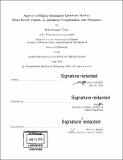| dc.description.abstract | We explore three incarnations of highly-entangled quantum matter: as descriptions of exotic, gapped phases in three spatial dimensions, as resources for fault-tolerant quantum computation, and as the by-product of the unitary evolution of a quantum state, on its approach to equilibrium. In Part 1, we study quantum information processing in platforms hosting Majorana zero modes. We demonstrate that certain highly-entangled states may be engineered in arrays of mesoscopic topological superconducting islands, and used for fault-tolerant quantum computation. We then discuss measurement-based protocols for braiding Majorana zero modes and detecting their non-Abelian statistics in on-going experiments on proximitized, semiconductor nanowires, before proposing new families of error-correcting codes for fermionic qubits, along with concrete realizations. In Part 11, we study gapped, three-dimensional phases of matter with sub-extensive topological degeneracy, and immobile point-like excitations - termed "fractons" - which cannot be moved without nucleating other excitations. We find two broad classes of fracton phases in which (i) composites of fractons form topological excitations with reduced mobility, or (ii) all topological excitations are strictly immobile. We demonstrate a duality between these phases and interacting systems with global symmetries along sub-systems, and use this to find new fracton phases, one of which may also be obtained by coupling an isotropic array of two-dimensional states with Z₂ topological order. We introduce a solvable model in which the fracton excitations are shown to carry a protected internal degeneracy, which provides a generalization of non-Abelian anyons in three spatial dimensions. In Part III, we investigate the dynamics of operator spreading and entanglement growth in quantum circuits composed of random, local unitary operators. We relate quantities averaged over realizations of the circuit, such as the purity of a sub-system and the out-of-time-ordered commutator of spatially-separated operators, to a fictitious, classical Markov process, which yields exact results for the evolution of these quantities in various spatial dimensions. Operator spreading is ballistic, with a front that broadens as a dimension-dependent power-law in time. In this setting, we also map the dynamics of entanglement growth in one dimension to the stochastic growth of an interface and to the Kardar-Parisi-Zhang equation, which leads to a description of entanglement dynamics in terms of an evolving "minimal cut" through the quantum circuit, and provides heuristics for entanglement growth in higher-dimensions. The material presented here is based on Ref. [1, 2, 3, 4, 5, 6, 7, 8, 9, 10]. Ref. [11, 12] are not discussed in this thesis, but were completed during my time at MIT. | en_US |
